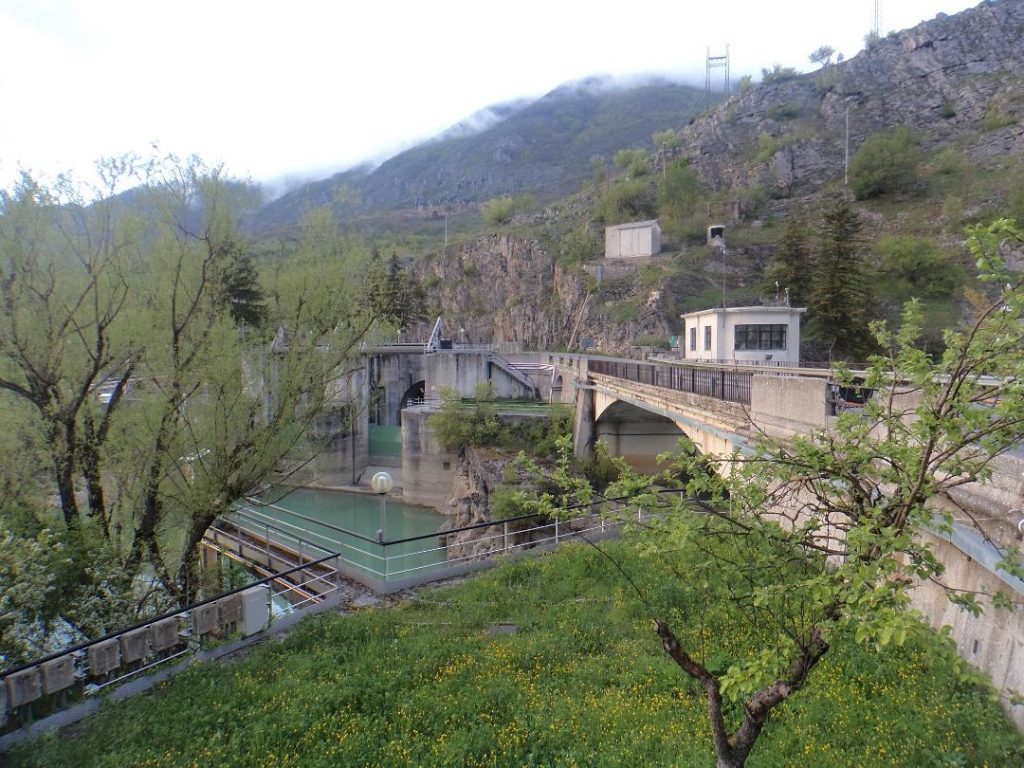
Lago Barrea – the dam, May 2019
The day following our arrival at Barrea was about as close to a rest day as we’d had up to that point. In the morning, apart from one mysterious neighbour coughing from one or other impossible-to-determine direction (the downside of tiled-floor buildings) everyone stayed asleep and I got to experiment with all the coffee pots and think about the disappointments of art compared to the relaxed there-ness of nature . . . needing no galleries or claustrophobic indoor spaces, free of language, free of contrivance.
The apartment in Treviso had been full of old Venice Biennale catalogues, serving only to emphasise, my no-doubt temperamentally judgemental, dissatisfaction with the art world. The sheer randomness of the art selected – at least as was highlighted in the catalogue – was astonishing. True, these collections were more challenging than the Grange-over-Sands or Wendover Art Club annual show, but as an international selection of art, page after page (with some notable exceptions) presented a thoroughly pick-n-miss bag of mind-rotting sweets. Whatever the old ads proclaimed, ‘Craven A’ cigarettes were always bad for you[i]. Our relativistic acceptance of mediocre art could prove equally detrimental to our long-term health. But perhaps society only gets the art it deserves? If everyone lived for a thousand years, would tastes converge, diverge or be forced to specialise? Would relativism triumph or would it be exposed?
So, what is it that I actually want / Will I know before I see it? / First god was dead / And then art / Followed slowly by the planet. / Does it come down to hope and faith / A truth inside the head? / Can everything flow back from that? / Renewed / Forever / Vivid?[ii]
Before I could decide about this, the coffee started to erupt all over the cooker. I can’t have put the grounds in the right place. At least the small blue flames dancing amongst the black liquid lava looked fiercely cheerful. I’d have to sieve it instead.
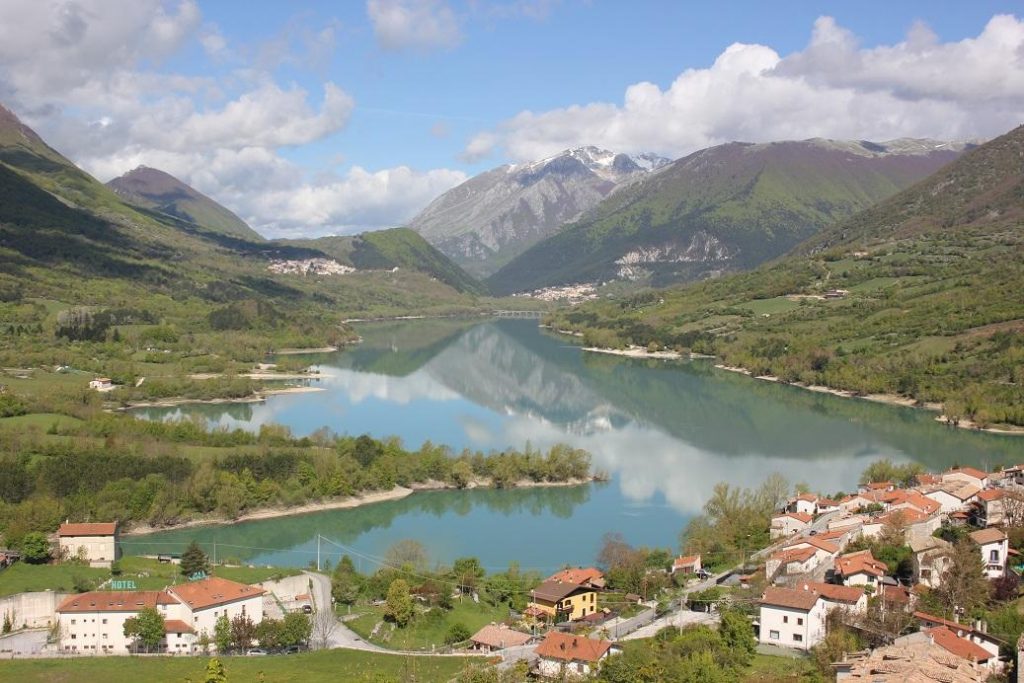
Lago Barrea from up near the bread shop 17th May 2019
On the way back from a relaxed uphill walk to the panetterria, we met a man with two dogs. One large, one small. Despite their sublime view of the lake, the dogs were only concerned with his recent purchases. Large dog’s sharp Alsatian ears were twitching. Small dog hyped up and ready. Suddenly, as if the temptation was more than could be borne, large dog grabbed the big cheese from the bench on which its owner rested, and set off down the street, packet between teeth. Small dog looked divided, head switching back and forth between disappearing colleague and disillusioned owner. Several times the man cried out, but the absconding canine took no notice. Struggling to his feet the man hobbled after his stolen cheese, waving his stick, shouting indignantly. Small dog scuttled off in pursuit. As the man vanished around a distant corner, we realised he’d left another package behind. Grabbing this warm paper wrapping, I ran after the procession, wondering which alley to follow in the maze ahead, finally glimpsing site of the quest lower down the hill. “Scusi,” I shouted, “Scusi,”, as I ran after them, which only appeared to spur the man on. Five minutes later, he must have given up the chase. By then he had his cheese back and was sitting wearily in a doorway. Large dog was looking contrite, small one, expectant again. Warily he regarded my approach. Finally, the light dawned as I presented his other abandoned package. “Grazie,” he smiled, recovering in a few breaths from life’s dismay. “Arriverderci,” he added as I walked away – leaving the dogs contemplating a second mutiny perhaps?
After a couple of hours on an empty section of the lakeshore, we climbed the hill to Civitella Alfedena[iii] the village above the lake at the far end (visible at centre-left, like a snowy hill in the photo above) to have lunch in the silent central square. Two friendly cats came to mew piteously for scraps, but then lay at our feet purring in the heat, as if our mere presence was enough to induce euphoria.

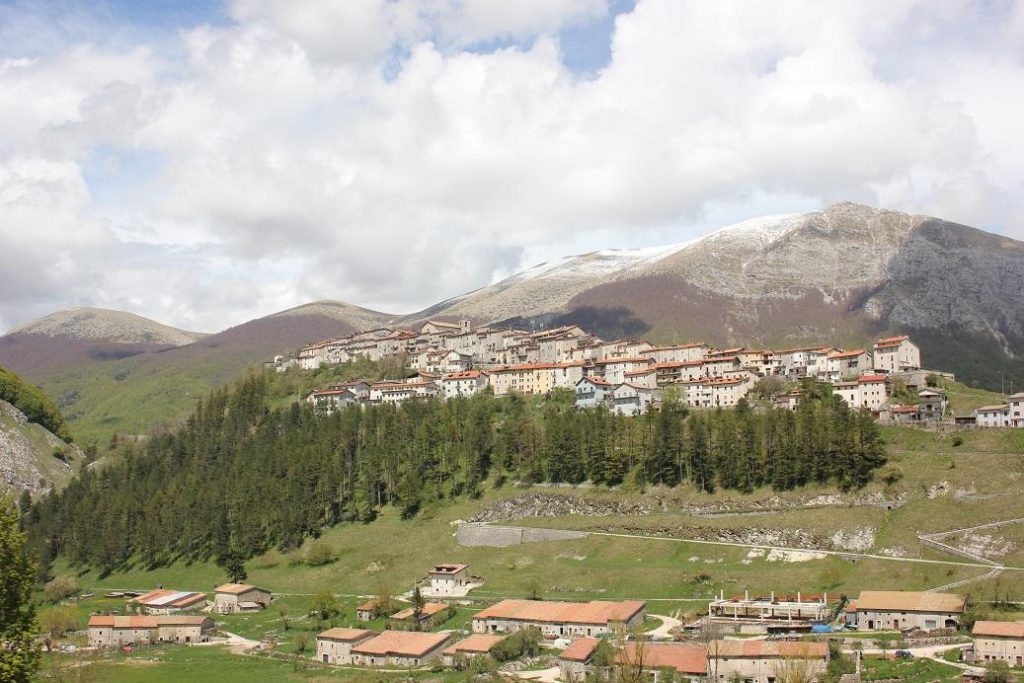
Opi 17thMay 2019
The hill town of Opi, 12 kilometres to the west was dramatic yet idle in the sun, the high mountain beechwoods around the Abruzzo border with Lazio, where we went for a long walk, intensely secretive – not a person, bear or wolf appearing in either sound or sight. On the carpets of wild violas under the canopies of leaves backed by snow-dusted mountains, it was cool and fresh.
18th May 2019
Being abroad, frequently induces an atmosphere of the Second World War in me – probably because the first encounter someone of my generation and background had with the Continent, came via war films. In retrospect however, it’s not the shock or grimness of Auschwitz or Anzio, Omaha Beach, Monte Cassino or Colditz in these films that lingers, but rather the everyday experience of civilians and ordinary combatants at moments far from the known historical flashpoints. The landscapes and quiet events in such films are much more likely to carry across and inhabit life as it remains now. While the decisive horror and violence, even the implausible action, remain vital lessons, however true they may be, they are stuck in time in the way that a girder bridge over a river border or a steep hanging forest on the snow-line of the Alps, is not. Almost every film, good or bad, has such establishing shots. Often this incidental backscene is of more value than the film itself.

Though I have imagination into the future, it seems to me that both the future and the present only gain relevance with reference to the past[iv] – hence, the fact that many of my generation and class, first experienced the Continent through war films, is more interesting than it might at first seem. Despite the often completely fictional nature of this early ‘experience’, a generalised memory of war and spy films, can be surprisingly creative in generating a frisson of overlap between eras, between then and now. Most of all, quite apart from a greater appreciation of the subtleties of landscape, architecture and national differences, the sense of menace or precariousness remembered from the best of such films, is almost bound to encourage a sharper awareness of the real world, a way of really paying attention to it. Without this attention, it’s all too easy to drift unquestioningly through the one-dimensional reality we expect to surround us.[v]
Connected to that older, necessarily less complacent reality of 1939-45, come the anecdotes of disappearing relatives and long dead grandparents and the now bizarre-seeming fact that in the late 60s, at my junior school of mostly London-overspill exiles, boys were still swapping their fathers collections of bullet cases, shrapnel and medals! (Generally speaking, the girls were more conditioned to be interested in skipping, dancing, and games involving those ‘jacks’ things that always reminded me of miniature tank traps[vi]). The recollection of the significance of such secondhand treasure, at first astonished me. But reading Kim Newman’s review of Overlord (2018): “With the passage of the years WWII has become what the Wild West used to be – a nebulous past of actual peril and limitless possibility,” I realised that to us kids on a council estate in 1968, encouraged by the authenticity of our props and fragments, that was what the Second World War already was. Our alleyways and building sites became a battleground – a battleground where sometimes the two genres Newman mentions, even mixed[vii]. A truer sense of the conflict only came later, when we were older . . . and sometimes breathed unexpectedly again from the travelling Continental scenes around us in Italy, as they echoed the landscapes in which I first saw it depicted.
Not long after we were back in Cumbria, another vivid parallel struck me from a letter sent by an old friend – one who once lived on the same housing estate and went to the same schools as I. He reminded me of the Italian community in Aylesbury back then: “Do you remember Imbriano, the Ambrosios, Pino, Mattozas Bakery, Havelock Street in the 1970 World Cup,[viii] Peter’s hairdressers, those women in black on kitchen chairs outside terrace houses along New Street like (they were actually) Sicilian, Calabrian peasants? I feel as if I grew up in Italy. When I first went to southern Italy, it reminded me of Aylesbury in the summer.”
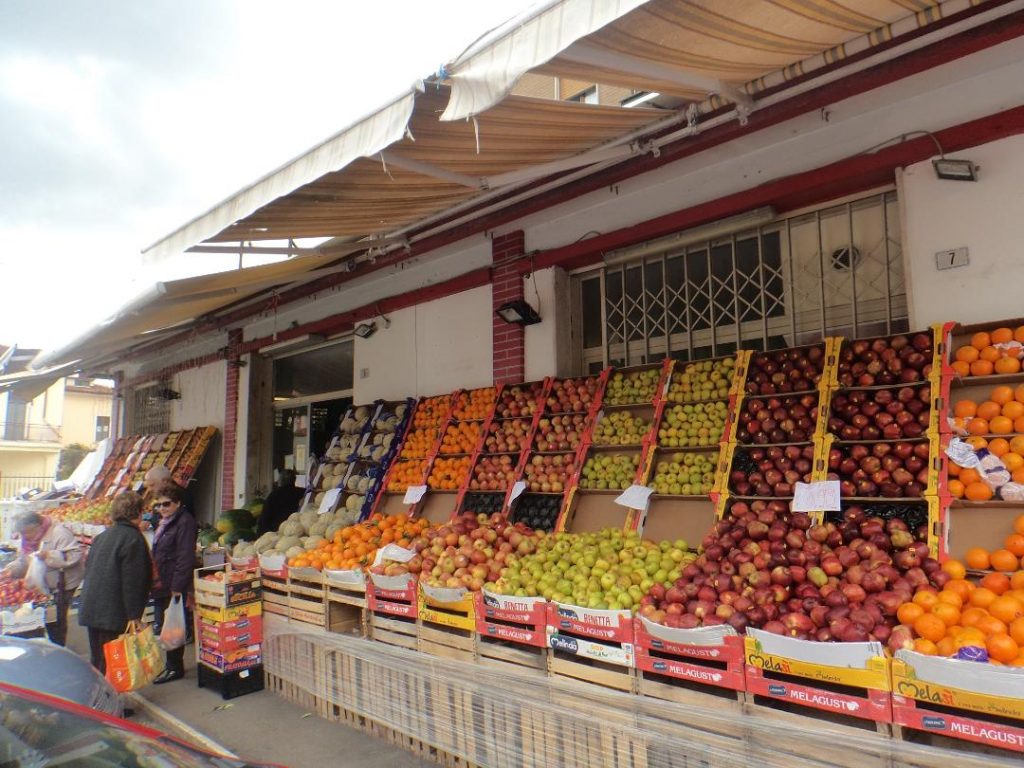
A fruit stall may defy both its era and its location . . .
My friend’s recollections revived windows and roads that had lain dormant in my own mind: and even if all such personal memories are poetically enhanced and condense many separate occasions and summers, in doing so, they also unite them in a hopeful and generous richness – one that decries racism and Brexit; one that echoes multicultural life in towns and cities all over Britain to this day – which in my experience, though it may be tainted by clear rivalries and sporadic intolerance, is rarely as antagonistically set as the narrow-minded inciters would have us believe. On the other hand, I do accept that the glow of memory can invoke a sentimental piety, a nostalgia which looks back too fondly – no doubt in an attempt to counteract the entire mess humanity is in, politically, culturally and environmentally . . .
18th May 2019 continued
We climbed away from Barrea and Opi through the mountains in increasing drizzle. Drizzle and mist soon became a heavier rain, only thankfully relieved by intermittent bursts of sun during the long, winding and blindspot blinkered descent to San Benedetto dei Marsi, on the eastern circumference of the Piana del Fucino.
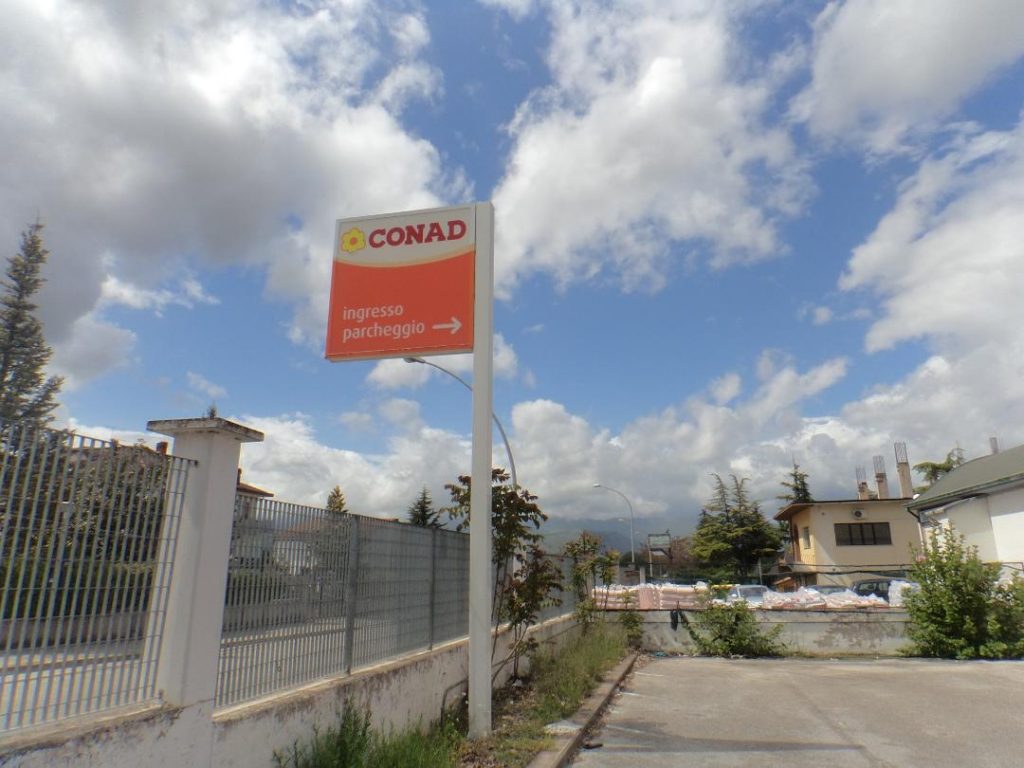
Conad cloudscape by the dangerous junction, blueness breaking out, San Benedetto dei Marsi.
Low on supplies, we stopped at a peripheral Conad, situated by a junction with no apparent priorities. In the twenty minutes I hung about outside, there were at least three serious near misses (one between a tanker and a van) and one minor altercation, despite that the place was more village than town.
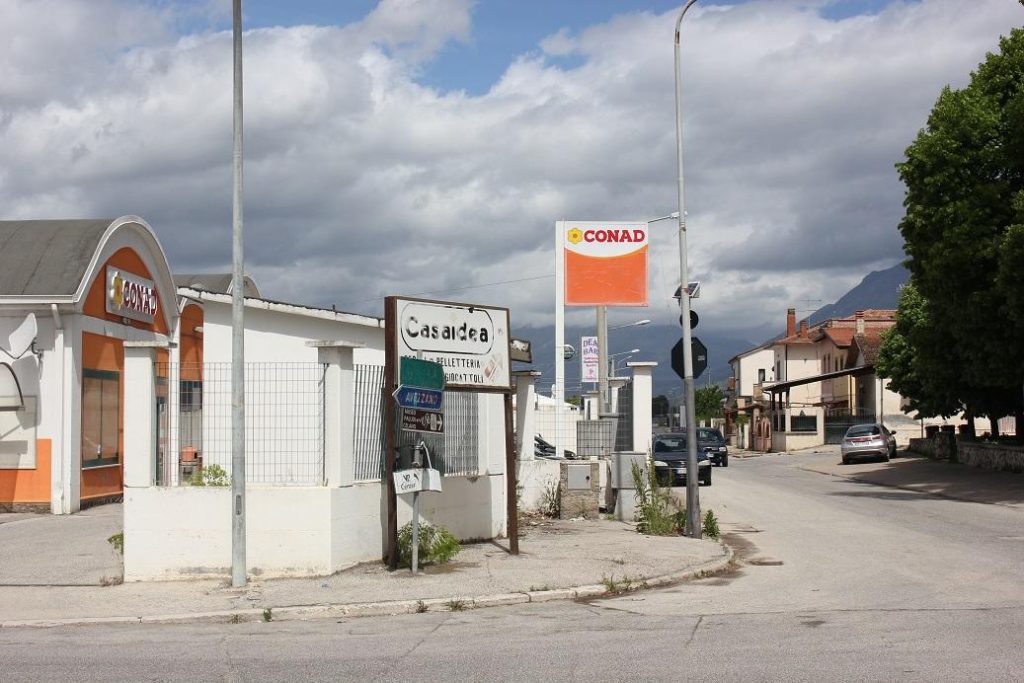
Had it been built 200 years earlier, would Conad have been on the shores of a lake? 18th May 2019
In litter-filled shade to the east of Conad, on a green space of sorts, stands a striking war memorial, reminiscent of both Russian constructivist art and the social realism of the 30s. Here I sat for a while, contemplating its giant hands of friendship and their uniting sun, which bore an uncomfortable resemblance to a very spiky mace – as if the combatants had finally succeeded in knocking each other’s heads off. Now their robotic, columnal replacements were finally magnanimous or braindead enough to shake on it. Not that this prevented me from preferring such a monument to the more traditional style of pointless, over-sized, garden ornament.
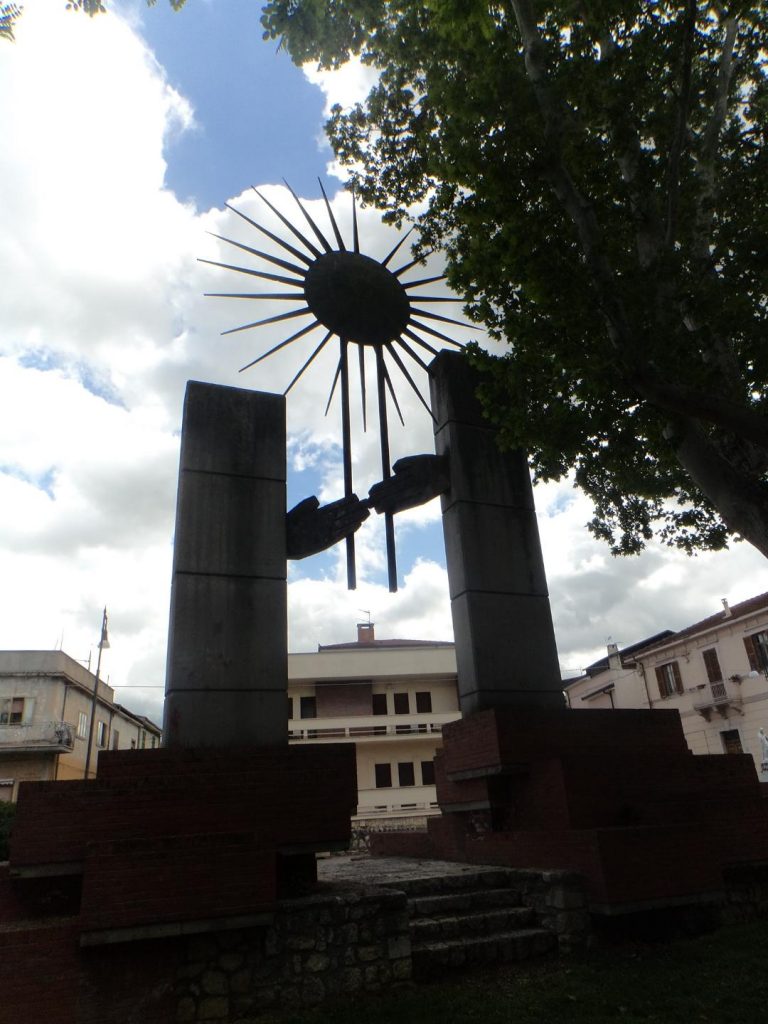
Shake on it before it’s too late . . .
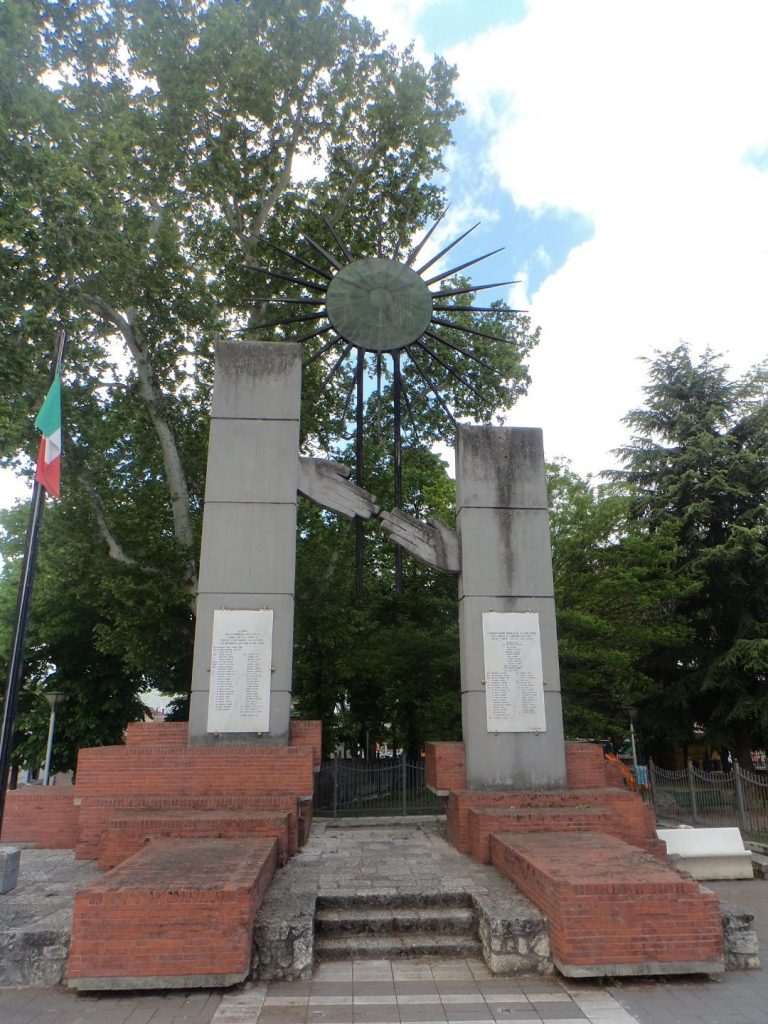
It’s already too late . . .
Via the centre of the drained Fucine Lake – the full story of which is truly fascinating[ix] – following a grid of dead straight roads, eventually we arrived at Avezzano. Yet to find our way out avoiding the big toll roads, was almost as hard and repeatedly futile as earlier Roman efforts were to control the lake over whose shore the city must once have gazed. At one time the third largest in Italy, this endorheic lake – one without external outflow – was believed by the Romans to harbour malaria and was also responsible for repeated flooding. Epic tunnels dug through mountains were temporarily successful in lowering the water level. The first effort employed 30,000 workers, presumably slaves, over eleven years, but sections of tunnel soon collapsed amid accusations of deliberate sabotage to conceal the siphoning-off of funds. At one stage even Hadrian had a go – yet with the collapse of the Roman Empire, not surprisingly, this canal eventually silted up. Fucine Lake was finally drained entirely by a Swiss engineer in the 19th Century.
Totally destroyed by earthquake in 1915, the city of Avezzano had to be rebuilt yet again after Allied bombing in 1944. Although the area is one of the most fertile in Italy, I found the atmosphere inside the vast amphitheatre – with oversized machinery trolling about the unnatural grid of fields and a suspicious-looking Telespazio satellite farm – faintly sinister. Of course, on another day, in another mood, it might appear quite differently. Certainly, some of the light-industrial shopping areas of Avezzano on the older road out towards Scurcola Marsicana and ultimately Rome, were more vividly reminiscent of 50s U.S.A.[x] than anything European. Unfortunately, as driver on busy roads in persistent rain, I could only verbalise my excitement for these veiled and rundown anachronisms, which many would consider standard, monotonous background. Glimpses caught or missed on film, were distinctly underwhelming: “Quick! Quick! Film that bit!” I’d shout, nodding my head towards a façade beyond a mass of parked cars, sleet, condensation and those eternal Fiat blindspots . . .
Rain continued through Tagliacozzo and on to Colli di Monte Bove, after which we trailed some obscure and very minor back roads which felt totally contradictory to my sense of direction. In heavy mist as well, we were tracked for a couple of miles by some or other branch of the fuzz, as if they were trying to pressure me into making a mistake. Eventually they buzzed off and soon afterwards, as if to celebrate the occasion, the sun broke out again. By a small railway bridge in the middle of nowhere, we found a formaggio seller’s abode, but although a radio was on inside the shuttered house, no-one emerged in response to all our loud knocks. A sign helpfully requested that customers should ring the bell hanging by the door, but we’d already tried that repeatedly.
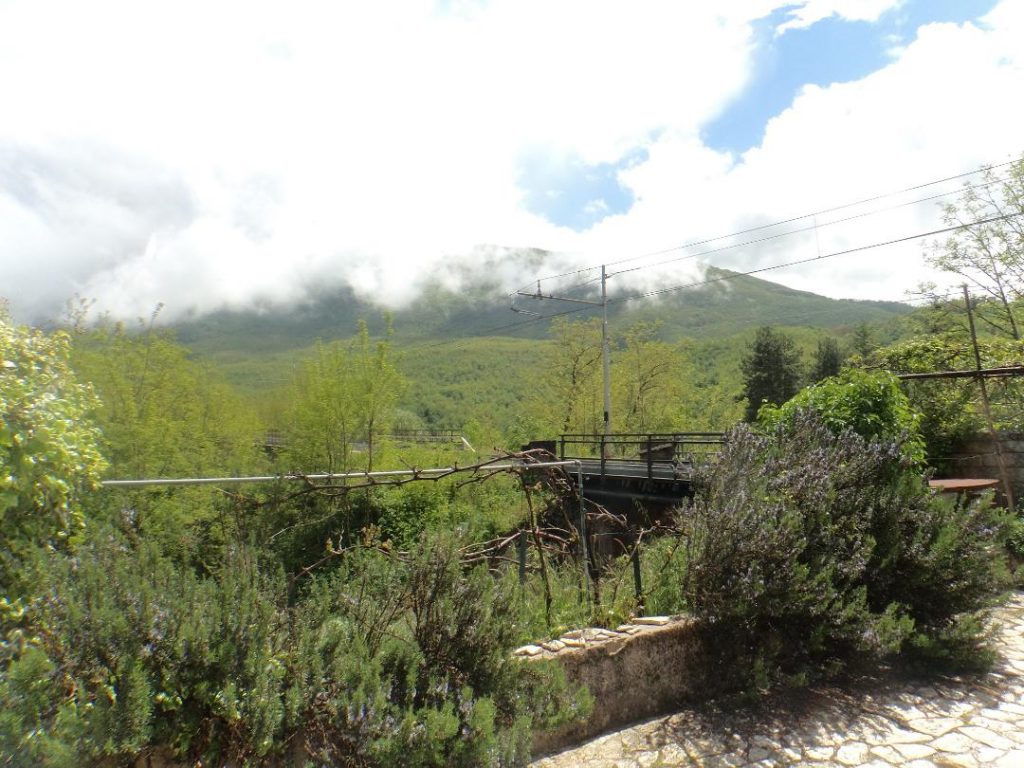
Camouflaged railway bridge from the deserted cheese-seller’s front yard.
Arriving with relief after miles of rain and lost directions, our high-ceilinged, 4th floor apartment on the Via Liberia[xi] at Castel Madama was a real time warp. Though clearly twentieth century, it was impossible to decide when exactly these apartments were built. Slightly bland from the outside, they possessed expensive solid doors and stairways. Utilitarian at the back, the vast front window led to a balcony putting on more style: with bowed railings atop plastered stone, this high view above the street, quietly hummed the 1950s. Full of furniture from the 30s to the 60s and with background décor unadulterated since the 70s, it was just the sort of place my grandparents might have liked, had they been better-off and lived in a warmer climate. The atmosphere was so reminiscent of their council flat off the Mortlake Road in London – but for one crucial difference: scale. Every room here had four times the floor area and twice the height.
Less dated were some of the magazines that kicked about the place. As you would expect, most of these were trash – which has probably become the best definition of magazines generally[xii]: Magazine /maɡəˈziːn/ noun
- a container or detachable receptacle for holding a supply of cartridges to be fed automatically to the breech of a gun.
- a glossy production containing reams of pointless misdirection, celebrity worship and inanity, certainly worth far less than the paper it’s printed on.
But, on a sideboard, I did discover a couple of film and lifestyle magazines – not hugely further up the evolutionary scale, but worth a cursory glance. One article featured a film I had never heard of: O.K. Nero (1951) – or O.K. Nerone, to use its original Italian title[xiii]. Reading a plot summary of this (Two American sailors, Fiorello and Jimmy, are slugged while sight-seeing in Rome and, together, dream they are back in Rome in the days of Nero), it sounded like a less-surreal, faintly more explicable, remake of the bizarre but endearing (to me, anyway) Fiddler’s Three (1944)[xiv] (A pair of Jolly Jack Tars on shore leave take a Wren (lady sailor) to Stonehenge and get caught in a time warp, finishing up in ancient Rome in the time of Nero). This similarity could be a co-incidence, but no doubt recycling a plot involving ancient Rome, would seem worth it, if it meant the filmmakers could get away with displaying buxom women in Roman gowns showing a lot of thigh. Fiddler’s Three by contrast, had to make do with a cross-dressing Tommy Trinder with bananas all over his head, parodying Carmen Miranda.[xv] “That idiotic film might do it for the English but is hardly going to work for the Italians!” K laughed, trying desperately to forget that she had ever, ever been persuaded, once, many years ago, to watch, Fiddler’s Three.
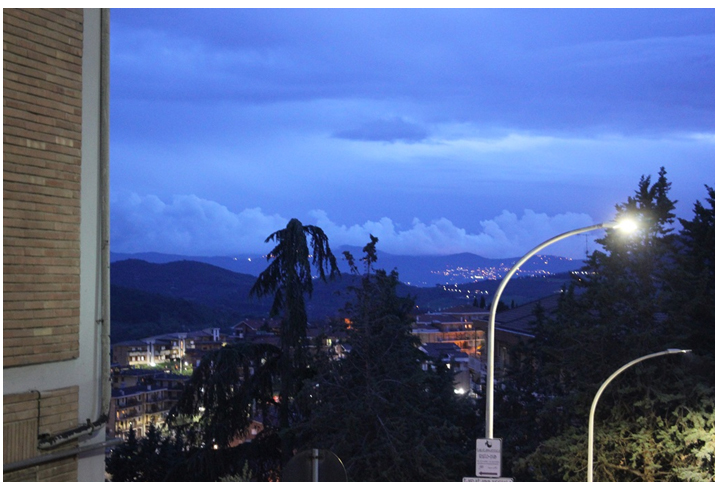
Nightscape, Castel Madama, May 2019
Lawrence Freiesleben, Italy and Cumbria, July-August 2019
Notes
[i] To be fair, I never found an advertisement with the slogan that they were “good for your throat” only that they were easy on your throat or something similar: https://flashbak.com/ten-beautiful-craven-a-cigarette-ads-from-the-1930s-19884/
[ii] From ‘Captain Black’, July 2019
[iii] https://en.wikipedia.org/wiki/Civitella_Alfedena
[iv] Detached; by itself; the apparent ‘present’ has little value apart from the rare times when – everything coming into greater focus – you become aware of its transience in a visionary way. This unusual state has none of the careless greed or surface-surfing selfishness of ‘living in the moment’. This is the moment incorporating everything valuable that came before it and sensing everything valuable that may follow. Living in everything, would be a closer way to describe it. It is through the very intensity of the experience of time, that time is overcome.
[v] Finally reading Colin Wilson’s, perhaps unfortunately titled, Beyond The Occult, (1988, ISBN 0-593-01174-0 Chapter 3, page 82 of the Bantam Press edition) 30 years after he recommended it in a letter (I believe he wrote hundreds of such letters every week, assiduously answering every reader’s query), I came across this interesting section, serendipitously perhaps?
“. . . when man experiences only one reality at a time, he is bored. A child experiences happiness when he is sitting beside a warm fire on a winter’s night with the rain beating on the windows, or when he is lying on a beach on a summer day with the great cold expanse of the sea in front of him. For he is in effect in two places at once: in the warm room, and out there in the freezing rain; or on the sunny beach, and out there on the cold and fathomless sea. This is why children love to hear ghost stories when they feel comfortable and secure: it is a way of being in two places at once. Dr Johnson’s Prince Rasselas is not only stuck in the present moment, but in a state of mind that might be called ‘mono-consciousness’. The child listening to a ghost story is in ‘duo-consciousness’.”
“. . . there are times when duo-consciousness becomes so intense that it ceases to be an exercise in imagination and takes on a compelling quality of reality.”
[vi] https://www.amazon.com/Channel-Craft-Jumbo-Classic-Vintage/dp/B000BIZ86W
[vii] Not unlike such daft combinations of genres as Billy the Kid versus Dracula (1966) https://www.imdb.com/title/tt0060168/?ref_=fn_al_tt_1
[viii] The World Cup was the one thing my friend mentioned that I did not remember, and I had to look up the match in which Brazil beat Italy by 4 goals to 1 – which must have caused massive dismay among our friends and enemies of Italian descent. Football was always a bit of a blindspot in our household despite my Liverpudlian Uncle Ken (unkindly known as Uncle Chessboard Teeth) and his obsession with Match of the Day.
[ix] https://en.wikipedia.org/wiki/Fucine_Lake
[x] Were they reconstructed after the war utilizing U.S. money and designs? – a vague theory of mine I’ve been unable to substantiate.
[xi] Rather than my assumption of Free Street – which lurched me into assuming a post-war provenance – Via Libera seems to translate as ‘green light’, ‘go-ahead’ or ‘all clear’?
[xii] With the stress on generally. Amongst the unhappy overload of wasted printing ink in newsagents, I’m sure many valuable magazines remain tucked away. Sight and Sound for example, to which I’ve subscribed since the 1990s.
[xiii] https://www.imdb.com/title/tt0043870/?ref_=nv_sr_1?ref_=nv_sr_1
[xiv] https://www.imdb.com/title/tt0036820/?ref_=nv_sr_2?ref_=nv_sr_2
[xv] A slight misrepresentation on my part, as Fiddler’s Three also has the captivating Diana Decker in some dubious, supposed Roman costumes (it was wartime after all) which almost rival those of O.K. Nerone, as well as Frances Day and the unforgettable Elisabeth Welch, not to mention the brilliant Francis L Sullivan as Nero.
